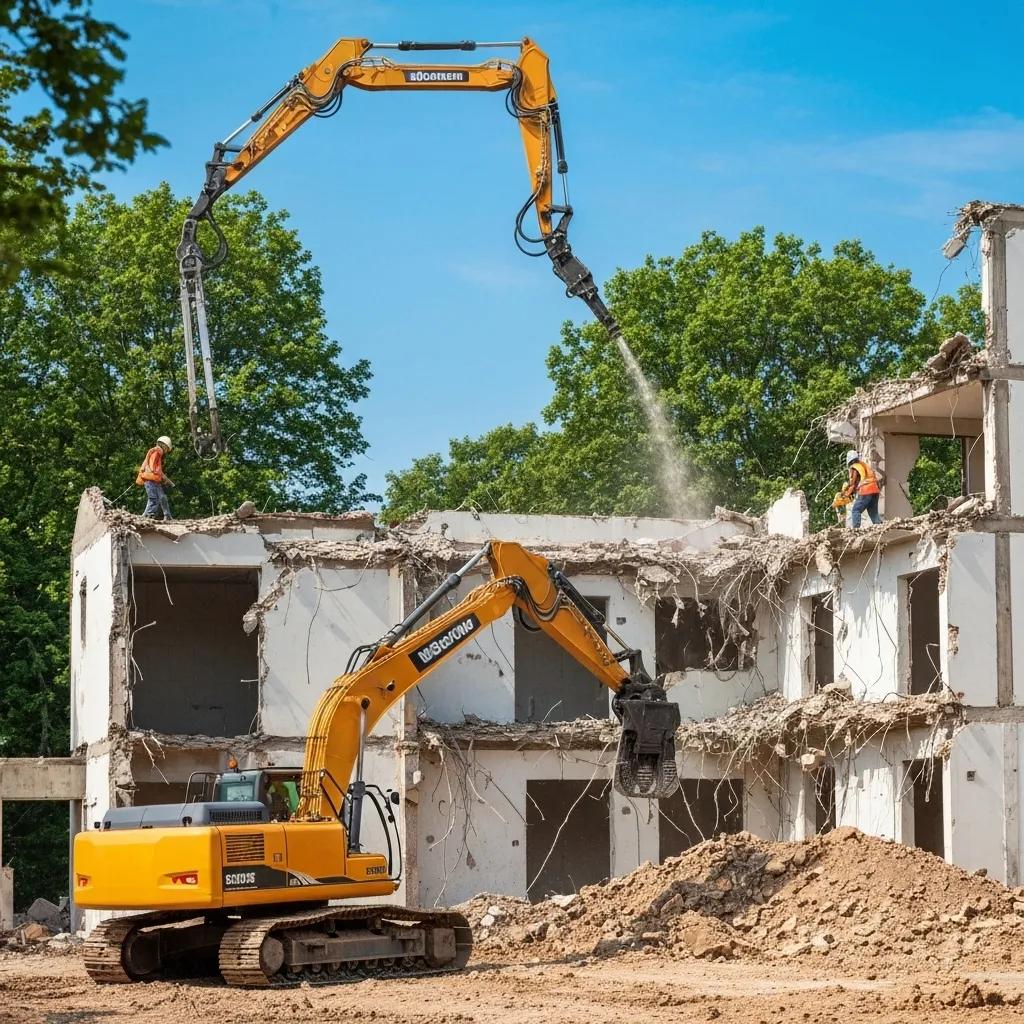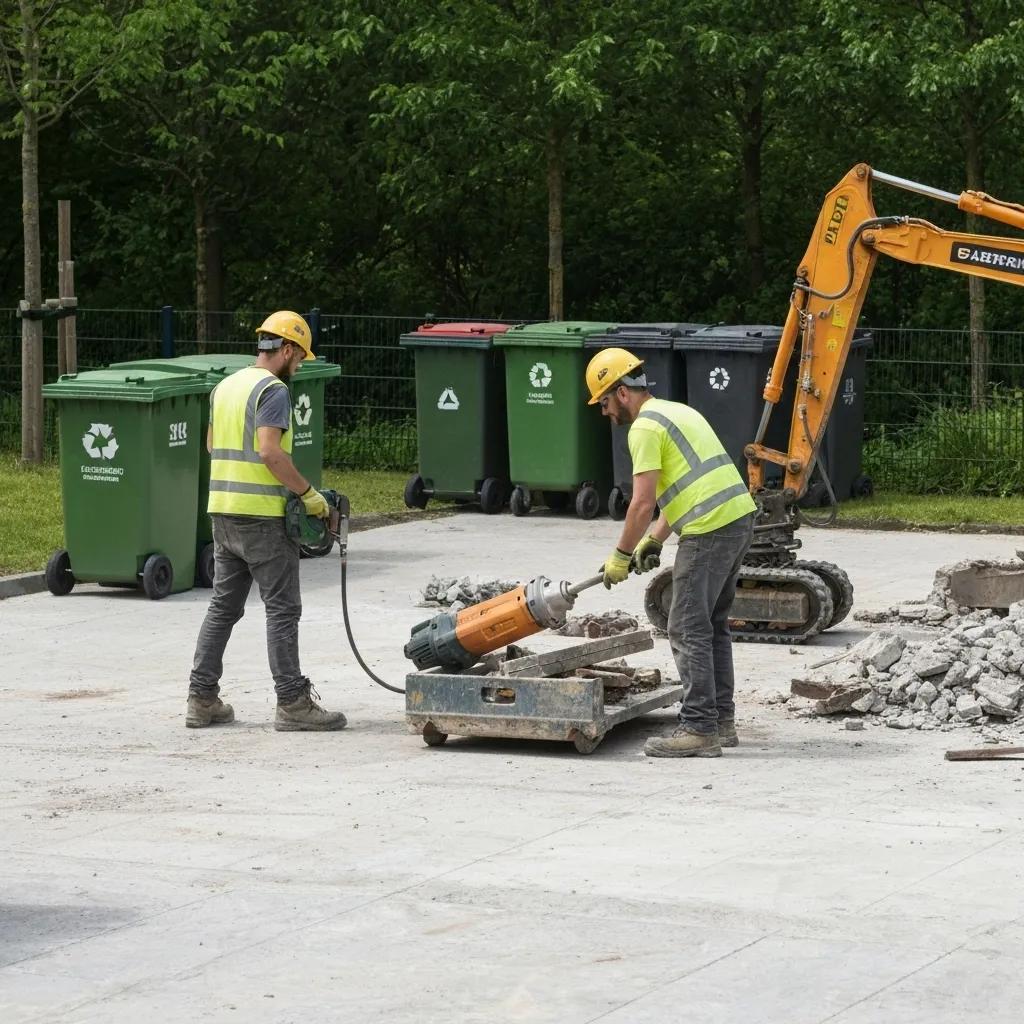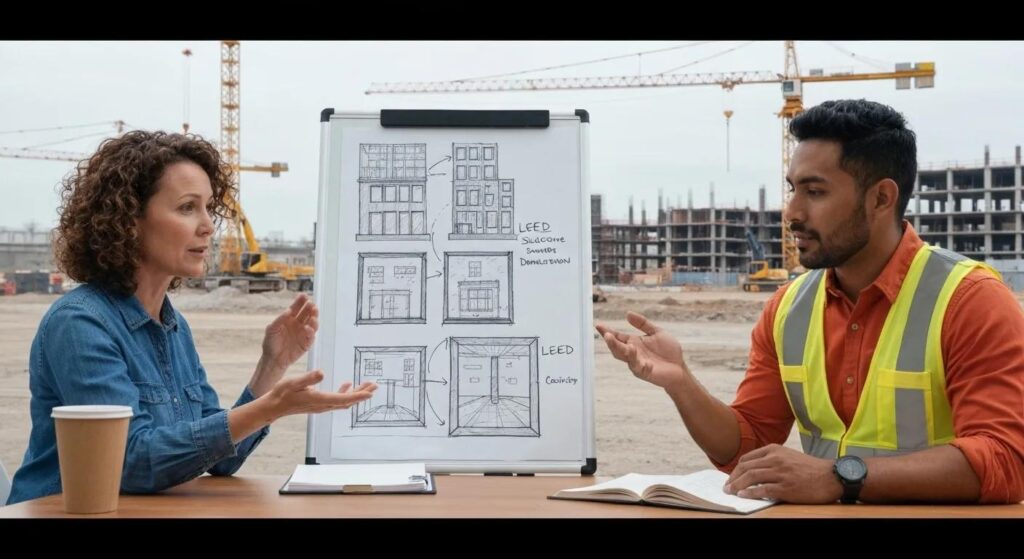Selective Demolition: Eco-Friendly Techniques Explained

Selective Demolition: How Eco-Friendly Techniques Reduce Waste and Earn LEED Credits
Selective demolition is revolutionizing construction site preparation by enabling the targeted removal of structural components to maximize material recovery, minimize landfill waste, and support LEED certification goals. You’ll discover why this precise approach outperforms traditional building teardowns, how eco-friendly methods drive carbon footprint reduction, and which strategies earn valuable LEED MRc5 credits. This guide covers core definitions, key features, environmental benefits, LEED integration, economic and ecological advantages of material reuse, the F5 Demolition difference, cost considerations, and actionable steps to launch your sustainable demolition project.
What Is Selective Demolition and How Does It Differ from Traditional Demolition?
Selective demolition is a deliberate process of dismantling specific parts of a structure to preserve and reuse valuable materials, reduce waste, and protect surrounding areas. This method enhances resource conservation by salvaging components rather than sending entire buildings to the landfill. For instance, reclaiming steel beams and hardwood flooring on-site minimizes raw material demand and disposal fees. These precise methods also underpin the eco-friendly techniques that reduce waste and unlock LEED credits.
What Are the Key Features of Selective Demolition?
Selective demolition delivers three primary advantages:
- Precision Removal: Contractors extract only designated elements, avoiding collateral damage to adjacent structures.
- Material Salvage: Valuable components like steel, wood, and masonry are recovered intact for recycling or reuse.
- Disruption Minimization: Controlled demolition limits dust, noise, and vibration, safeguarding occupants and infrastructure.
These focused capabilities distinguish selective methods from full-scale teardowns and lay the groundwork for sustainable site preparation.
How Does Selective Demolition Support Sustainable Construction?
Selective demolition supports green building by integrating:
- Deconstruction Practices: Systematic disassembly prioritizes recyclable streams.
- Resource Efficiency: Reclaimed materials reduce reliance on virgin resources.
- Circular Economy Principles: Salvaged components re-enter the supply chain, extending material life cycles.
By emphasizing reuse over disposal, selective demolition elevates sustainability metrics and reduces embodied energy in new construction.
Why Choose a Specialized Demolition Contractor for Selective Demolition?
Working with experts ensures safety, compliance, and efficiency:
- Technical Expertise: Trained professionals follow rigorous plans to prevent structural hazards.
- Regulatory Compliance: Licensed contractors navigate local building codes and waste-handling regulations.
- Project Efficiency: Specialized equipment and methods accelerate timelines and lower overall costs.
Selecting a qualified demolition partner secures precise execution and paves the way for waste reduction and LEED credit eligibility.
Understanding these distinctions sets the stage for exploring eco-friendly demolition techniques that minimize waste and reduce carbon footprints.
How Do Eco-Friendly Demolition Techniques Minimize Waste and Environmental Impact?
Eco-friendly demolition combines advanced tools and deconstruction methods to divert materials from landfills, lower emissions, and protect air and water quality. By prioritizing on-site sorting, low-impact equipment, and real-time monitoring, these approaches yield measurable reductions in waste volume and greenhouse gas output.
What Are the Most Effective Eco-Friendly Techniques in Selective Demolition?

The following techniques consistently deliver superior environmental performance:
- Deconstruction-First Strategy: Manually dismantle elements in reverse build order to maximize salvage.
- Low-Impact Machinery: Electric or hydraulic tools cut noise and emissions compared to diesel equipment.
- Dust and Noise Control: Water misting, temporary barriers, and sound-attenuating mats protect nearby communities.
Collectively, these tactics improve site conditions and enhance worker safety while accelerating material recovery.
How Does Selective Demolition Maximize Material Recovery and Recycling?
The table below shows how common demolition materials are processed for reuse:
| Material | Recovery Method | Outcome |
|---|---|---|
| Concrete | On-site crushing | Recycled aggregate for new concrete |
| Steel | Precision shearing | Melted and reformulated in mills |
| Wood | Manual de-nailing | Reused for framing or repurposed |
| Brick | Hand removal | Rebuilt into walls or landscaping |
How Does Waste Reduction Lower the Carbon Footprint of Demolition Projects?
Reducing waste through material reuse directly cuts embodied energy and greenhouse gas emissions.
- Reclaimed concrete avoids approximately 0.1 metric tons of CO₂ per ton of virgin cement.
- Salvaged steel spares about 1.46 metric tons of CO₂ per ton compared to new production.
- Reusing wood prevents deforestation and stores carbon in building assemblies.
By diverting debris, selective demolition shrinks carbon footprints and advances climate goals.
What Are the Statistics on Construction and Demolition Waste and Landfill Diversion?
Key industry figures highlight the impact of sustainable demolition:
| Category | Value | Reference Year |
|---|---|---|
| Total C&D Debris (U.S.) | 600 million tons | 2018 |
| Demolition Percentage of C&D Waste | 75–90 percent | 2018 |
| National Recovery Rate for C&D Waste | 76 percent | 2018 |
| Concrete & Asphalt Concrete Recovery | 95 percent | 2018 |
Construction and Demolition Waste Statistics
In the U.S., the total construction and demolition (C&D) debris generated in 2018 was approximately 600 million tons, with demolition accounting for about 75 to 90% of this waste. The national recovery rate for C&D waste was 76% in the same year, highlighting the potential for selective demolition to transform waste streams.
United States Environmental Protection Agency (EPA), “Construction and Demolition Debris” (2018)
These data points naturally lead into how selective demolition powers LEED credit achievement on green building projects.
How Can Selective Demolition Help You Earn LEED Credits for Your Project?

Selective demolition directly contributes to key LEED credits by documenting waste management plans, achieving diversion thresholds, and maximizing recycled content in new construction. Implementing a structured deconstruction approach aligns with MRc5 requirements and fosters higher certification levels.
What Is LEED Certification and Why Is It Important for Sustainable Demolition?
LEED (Leadership in Energy and Environmental Design) is a globally recognized rating system that measures a building’s environmental performance. Achieving LEED status:
- Validates sustainable site selection and material reuse strategies.
- Enhances marketability through green building credentials.
- Drives occupant health and operational savings.
Integrating selective demolition early in design supports these objectives and elevates project performance.
LEED and Sustainable Construction
LEED certification is a globally recognized system that evaluates a building’s environmental performance, validating sustainable practices and enhancing marketability. Integrating selective demolition early in the design process supports these objectives and elevates project performance, contributing to higher certification levels.
U.S. Green Building Council
This supports the article’s claims about the importance of LEED certification in sustainable demolition projects.
How Does Selective Demolition Contribute to LEED MRc5 Construction and Demolition Waste Management?
Selective methods fulfill MRc5 by:
- Establishing a Waste Management Plan that tracks material streams.
- Meeting minimum diversion rates (50 percent for one credit, 75 percent for two credits).
- Documenting salvaged and recycled percentages for each category.
This structured approach secures valuable LEED points and underscores project transparency.
What Are the Key Strategies to Maximize LEED Points Through Demolition?
Effective tactics to optimize LEED MRc5 credits include:
| Strategy | Tactic | Potential Credit |
|---|---|---|
| Comprehensive Planning | Develop and share detailed waste plan | 1–2 points |
| High Diversion Targets | Achieve ≥75 percent diversion rate | 2 points |
| Material Stream Separation | Sort and label concrete, metal, wood, brick | Supports documentation |
Implementing these strategies ensures predictable credit outcomes and supports higher LEED certification levels.
Can You See Real Examples of LEED Credits Earned Through Selective Demolition?
In one recent project, F5 Demolition salvaged 85 percent of interior finishes and structural elements, reducing landfill waste by 120 tons and delivering MRc5 credits that contributed to LEED Silver certification. This case highlights how precise deconstruction and rigorous documentation translate into measurable environmental and certification gains.
Demonstrating these successes reinforces the economic and ecological value of material reuse in selective demolition.
What Are the Economic and Environmental Benefits of Material Reuse in Selective Demolition?
Material reuse offers cost savings, resource conservation, and reduced environmental impact that extend far beyond simple waste diversion. By embedding reclaimed components in new construction, projects benefit from lower material costs and minimized extraction impacts.
Economic Benefits of Material Reuse
Material reuse in selective demolition offers cost savings through reduced disposal fees, material credits, and potential incentives. These financial benefits improve project budgets while reinforcing sustainable goals, making eco-driven demolition a financially sound choice.
“Benefits of Deconstruction,” Building Materials Reuse Association
How Does Material Salvage Support the Circular Economy and Resource Conservation?
Recovering materials drives circularity by:
- Reducing demand for virgin raw materials in manufacturing.
- Extending product life cycles and preventing premature disposal.
- Lowering embodied energy associated with extraction and processing.
This closed-loop model conserves natural resources and supports local recycling markets.
What Are the Cost Advantages of Eco-Friendly Demolition and Material Reuse?
Eco-driven demolition yields financial benefits:
- Disposal Fee Reduction: Lower landfill tipping fees by up to 30 percent.
- Material Credit: Offset new material purchases with salvaged components.
- Incentives: Qualify for local rebates and tax credits tied to green building practices.
These savings improve project budgets while reinforcing sustainable goals.
How Does Material Reuse Reduce Environmental Impact Beyond Waste Diversion?
Reusing components delivers multiple ecological benefits:
- Cuts greenhouse gas emissions from raw material production.
- Decreases landfill methane release by diverting organic materials.
- Limits land-use impacts by extending the functional lifespan of existing resources.
By embedding reclaimed materials in new builds, projects achieve deeper environmental performance gains.
These economic and ecological advantages highlight why clients choose specialized sustainable demolition services.
Why Choose F5 Demolition for Your Selective Demolition and Sustainable Project Needs?
F5 Demolition combines local expertise, safety protocols, and eco-focused processes to deliver precision selective demolition that aligns with your sustainability objectives and LEED certification requirements.
How Does F5 Demolition Ensure Precision, Safety, and Efficiency in Selective Demolition?
F5 Demolition’s approach features:
- Detailed Site Assessments: Identify salvage targets and risk zones.
- Specialized Equipment: Electric and hydraulic tools for low-impact dismantling.
- Trained Teams: Certified professionals follow OSHA-compliant safety procedures.
This disciplined methodology accelerates timelines, protects onsite personnel, and maximizes material recovery.
What Local Knowledge Does F5 Demolition Bring to Projects in Yukon and Ardmore, OK?
With deep regional experience, F5 Demolition:
- Navigates Oklahoma’s waste handling and recycling regulations.
- Coordinates with local transfer stations and recycling centers.
- Leverages community partnerships to streamline material resale and donation.
How Does F5 Demolition Support LEED Certification and Environmental Responsibility?
As your demolition partner, F5 Demolition:
- Develops and implements comprehensive waste management plans.
- Tracks diversion rates and documents material streams for LEED submittals.
- Collaborates with architects and construction teams to integrate reclaimed resources.
These services position your project for successful green building certification and showcase environmental leadership.
With F5 Demolition’s expertise in sustainable selective demolition, you can pursue your green building goals confidently and begin estimating project costs effectively.
How Much Does Selective Demolition Cost and What Factors Affect Pricing?
Selective demolition pricing depends on project size, material complexity, site conditions, and waste management targets. Transparent budgeting and clear cost-per-square-foot estimates help you plan accurately and optimize return on investment.
What Is the Typical Demolition Cost Per Square Foot for Eco-Friendly Selective Demolition?
The table below compares average costs:
| Project Type | Cost per Sq Ft | Notes |
|---|---|---|
| Commercial Selective Demolition | $3.00–$6.50 | Includes material sorting and salvage |
| Residential Selective Demolition | $2.50–$5.00 | Smaller scale and limited structural work |
These ranges reflect eco-driven processes that prioritize reuse and waste diversion.
How Do House Demolition Costs Compare to Sustainable Selective Demolition Services?
Full building teardown typically costs $8.00–$12.00 per sq ft, while sustainable selective demolition averages $4.00–$7.00 per sq ft. Savings stem from lower disposal fees and reclaimed material credits that offset demolition expenses.
How Can Choosing a LEED-Compliant Demolition Contractor Impact Your Project Budget?
Investing in a LEED-focused contractor delivers:
- Potential Tax Incentives: Federal or state rebates tied to green building certifications.
- Long-Term Savings: Reduced operational and material procurement costs.
- Enhanced Asset Value: Certified green buildings command premium lease or resale rates.
These factors often offset initial selective demolition premiums and support broader sustainability returns.
Accurate cost projections pave the way for a seamless transition into project execution and green certification.
How Can You Get Started with Selective Demolition Services for Sustainable and LEED-Certified Projects?
Launching a selective demolition project involves clear planning, professional guidance, and precise coordination. The following steps help you prepare for an eco-friendly teardown that aligns with your sustainability targets.
What Are the Steps to Plan and Execute a Selective Demolition Project?
- Conduct a Site Assessment to identify salvageable materials and hazardous components.
- Develop a Waste Management Plan outlining material streams and diversion targets.
- Perform Deconstruction Sequencing to break down structures in reverse build order.
- Implement On-Site Sorting Stations for concrete, metal, wood, and brick.
- Coordinate Material Distribution with recycling partners or reuse vendors.
These steps create a structured approach that ensures efficient execution and measurable waste reduction.
How Do You Request a Quote or Contact F5 Demolition for Eco-Friendly Demolition Services?
To initiate your sustainable selective demolition, call us at 405-369-7969 or visit F5 Demolition and complete the online contact form. Our team will provide a detailed assessment, cost estimate, and project timeline tailored to your LEED certification objectives.
This direct outreach sets the foundation for transparent collaboration and optimized demolition planning.
What Questions Should You Ask Your Demolition Contractor About Sustainability and LEED?
When evaluating providers, inquire about:
- Documented Waste Diversion Rates and MRc5 achievements.
- Detailed Waste Management Planning and reporting procedures.
- Equipment Types and Emissions Controls used onsite.
- Experience with LEED submittals and credit documentation.
These questions ensure alignment with your environmental goals and certification requirements.
By following these guidelines and partnering with a specialized contractor, you can achieve sustainable, cost-effective, and LEED-ready demolition outcomes.
Four key benefits emerge from selective demolition: precise material recovery, minimized environmental impact, LEED credit attainment, and economic savings. Integrating eco-friendly techniques into your demolition plan positions you for a smoother construction transition and stronger sustainability credentials.
As you prepare for your next project, leverage the insights and services outlined here to deliver superior environmental performance. Reach out to F5 Demolition to turn your green building vision into reality.
